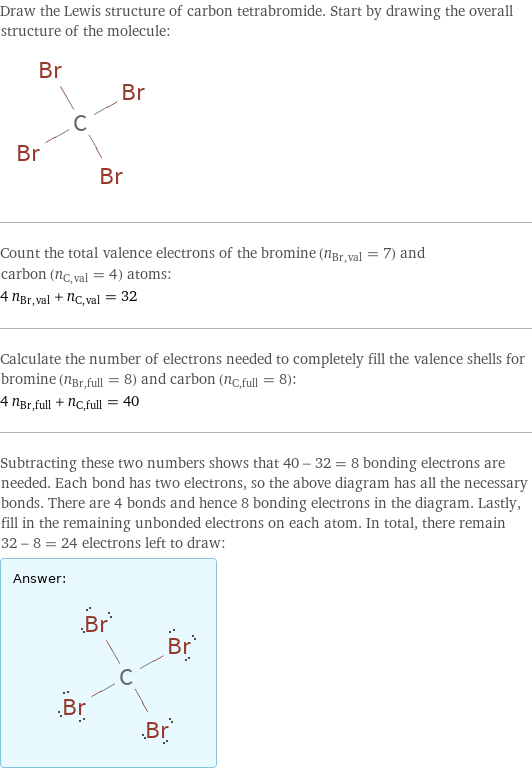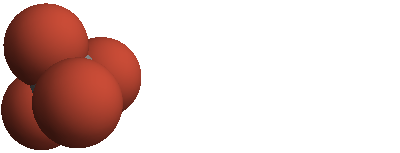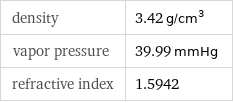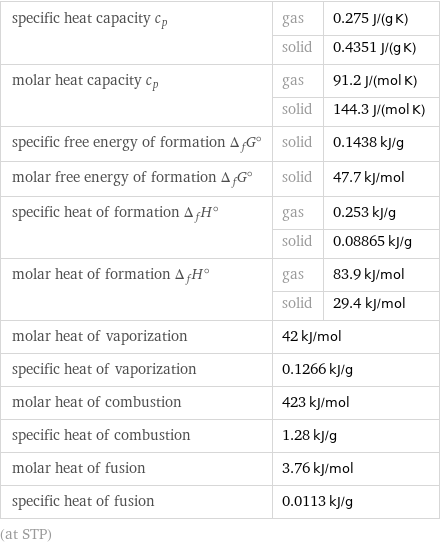Input interpretation

carbon tetrabromide
Chemical names and formulas

formula | CBr_4 name | carbon tetrabromide alternate names | carbon bromide | methane tetrabromide | tetrabromomethane mass fractions | Br (bromine) 96.4% | C (carbon) 3.62%
Lewis structure

Draw the Lewis structure of carbon tetrabromide. Start by drawing the overall structure of the molecule: Count the total valence electrons of the bromine (n_Br, val = 7) and carbon (n_C, val = 4) atoms: 4 n_Br, val + n_C, val = 32 Calculate the number of electrons needed to completely fill the valence shells for bromine (n_Br, full = 8) and carbon (n_C, full = 8): 4 n_Br, full + n_C, full = 40 Subtracting these two numbers shows that 40 - 32 = 8 bonding electrons are needed. Each bond has two electrons, so the above diagram has all the necessary bonds. There are 4 bonds and hence 8 bonding electrons in the diagram. Lastly, fill in the remaining unbonded electrons on each atom. In total, there remain 32 - 8 = 24 electrons left to draw: Answer: | |
3D structure

3D structure
Basic properties

molar mass | 331.63 g/mol phase | solid (at STP) melting point | 89 °C boiling point | 190 °C density | 3.42 g/cm^3 solubility in water | insoluble
Units

Solid properties (at STP)

density | 3.42 g/cm^3 vapor pressure | 39.99 mmHg refractive index | 1.5942
Units

Thermodynamic properties

specific heat capacity c_p | gas | 0.275 J/(g K) | solid | 0.4351 J/(g K) molar heat capacity c_p | gas | 91.2 J/(mol K) | solid | 144.3 J/(mol K) specific free energy of formation Δ_fG° | solid | 0.1438 kJ/g molar free energy of formation Δ_fG° | solid | 47.7 kJ/mol specific heat of formation Δ_fH° | gas | 0.253 kJ/g | solid | 0.08865 kJ/g molar heat of formation Δ_fH° | gas | 83.9 kJ/mol | solid | 29.4 kJ/mol molar heat of vaporization | 42 kJ/mol | specific heat of vaporization | 0.1266 kJ/g | molar heat of combustion | 423 kJ/mol | specific heat of combustion | 1.28 kJ/g | molar heat of fusion | 3.76 kJ/mol | specific heat of fusion | 0.0113 kJ/g | (at STP)
Chemical identifiers

CAS number | 558-13-4 Beilstein number | 1732799 PubChem CID number | 11205 PubChem SID number | 24892347 SMILES identifier | C(Br)(Br)(Br)Br InChI identifier | InChI=1/CBr4/c2-1(3, 4)5 RTECS number | FG4725000 MDL number | MFCD00000117
NFPA label

NFPA label

NFPA health rating | 2 NFPA fire rating | 0 NFPA reactivity rating | 0
Safety properties

flash point | 65 °C

DOT hazard class | 6.1 DOT numbers | 2516
Toxicity properties

lethal dosage | 1000 mg/kg (oral dose for rats) short-term exposure limit | 4 mg/m^3

probable lethal dose for man | 600 mL (milliliters) long-term exposure limit | 1.4 mg/m^3 (over 8 hours) RTECS classes | other